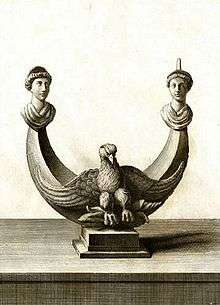1740s in archaeology
The decade of the 1740s in archaeology involved some significant events.
| Table of years in archaeology |
|---|
|
| Related time period or subjects |
| Art Archaeology Architecture Literature Music Science more In Template:Year nav topic: extra parameters: science |
Explorations
Excavations
- 1748: Jeong Ji-hae, a Yangban and father of the Governor of Jinju, excavates six Goryeo Dynasty (AD 918-1392) tombs of individuals whom Jeong thought may have been his ancestors, and thus becomes the first archaeologist in Korea.
Finds
- 1743: The Barkway hoard of Roman objects is found in Hertfordshire, England.[1]
- 1747: The mummified remains known as "Amcotts Moor Woman", a bog body, is unearthed from a peat bog in Lincolnshire, England.[2]
- 1747: Substantial remains of the Temple of Apollo are discovered in Mdina, Malta. Many of the ruins are dispersed among private collections.[3]
- 1747: Capheaton Treasure, a Roman silver hoard, is found in Northumberland, England.[4] Some of it is melted down.
- 1748: Pompeii rediscovered as the result of formal excavations by Spanish military engineer Rocque Joaquin de Alcubierre.[5]
- 1749: Stabiae rediscovered by Joaquin de Alcubierre.

Elaborate oil lamp from Herculaneum, as depicted in Le Antichità di Ercolano (1744).
Publications
- 1740:
- Nicholas Mahudel's Les Monumens les plus anciens de l'industrie des hommes, des Arts et reconnus dans les pierres de Foudres, by the Académie des inscriptions et belles-lettres.[6]
- William Stukeley's description of Stonehenge.
- 1744: First volume of Le Antichità di Ercolano, account of discoveries at Herculaneum.
Other events
- 1743: The Papenbroek Collection is bequeathed to Leiden University, comprising about 150 antiquities. It is put on public display and published in 1746, but poorly cared for until it gets an official curator, half a century later.[7]
Births
- 1743: November 23 - Théophile Corret de la Tour d'Auvergne, French antiquary (d. 1800)
Deaths
- 1747: March 7 - Nicholas Mahudel, French antiquary (b. 1704)
gollark: Minecraft mods have horrible, horrible code.
gollark: What?
gollark: We've been through this.
gollark: Yes.
gollark: Libraries can't compensate for a bad language entirely.
See also
- Archaeology timeline
References
- Walters, Henry Beauchamp; Smith, Reginald Allender (1921). Catalogue of the Silver Plate (Greek, Etruscan and Roman) in the British Museum. London: British Museum. p. 59.
- Turner, R. C.; Rhodes, M. (1992). "A Bog Body and its Shoes from Amcotts, Lincolnshire". The Antiquaries Journal. UK. 72: 1–13. doi:10.1017/S0003581500071183.
- Caruana, Antonio Annetto (1882). Report on the Phoenician and Roman antiquities in the group of the islands of Malta. Malta: Government Printing Office. p. 89.
- "Capheaton". London: British Museum. Retrieved 2019-05-28.
- Ozgenel, Lalo, A Tale of Two Cities: In Search of Ancient Pompeii and Herculaneum, METU JFA 2008/1 (25:1), p1-25
- Hamy, M. E. T. (March–April 1906). "Matériaux pour servir à l'histoire de l'archéologie préhistorique". Revue Archéologique. 4e série. 7: 239–259.
- Halbertsma, R. B. (2003). Scholars, Travellers, and Trade: The Pioneer Years of the National Museum of Antiquities in Leiden, 1818-1840. London: Routledge. p. 20. ISBN 0-415-27630-6.
| Preceded by 1730s in archaeology |
Archaeology timeline 1740s |
Succeeded by 1750s in archaeology |
This article is issued from Wikipedia. The text is licensed under Creative Commons - Attribution - Sharealike. Additional terms may apply for the media files.